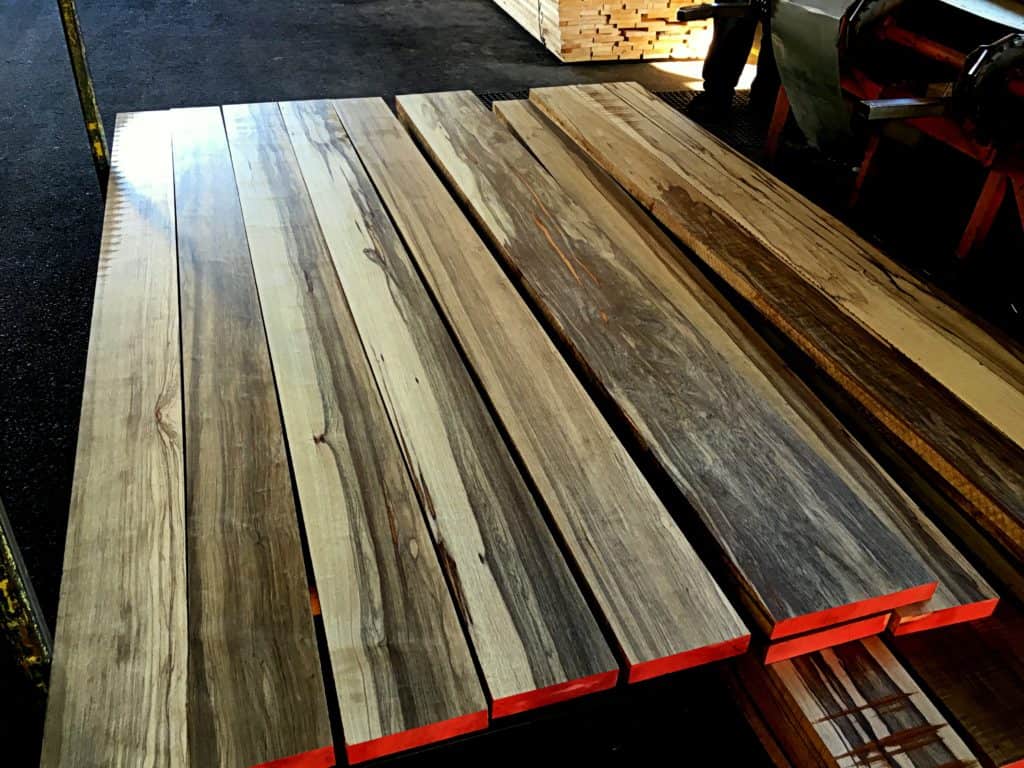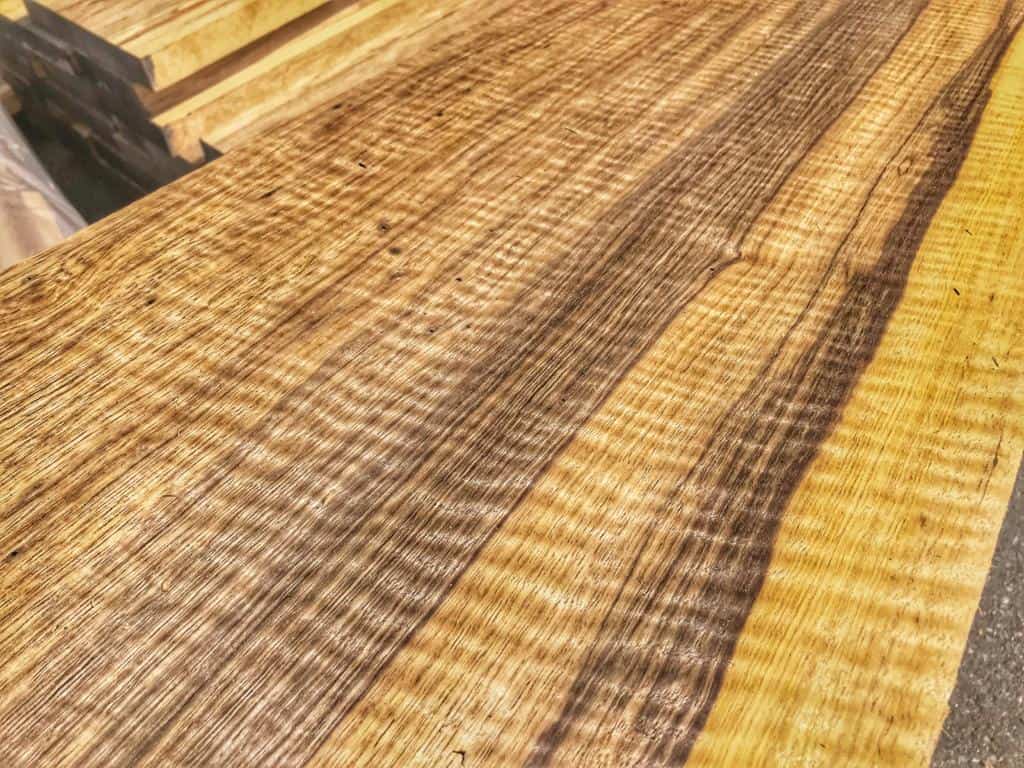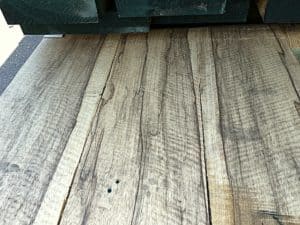Black Limba Lumber & Wood Guide

Limba Wood: Specie Data, Colors, Grade, Uses and Applications n
Black Limba is one of the most beautifully figured exotic hardwoods in the world. Accordingly, this African wood is regularly used for guitars, millwork, furniture or cabinet applications. Occasionally, customers make other wood products such as turnings, inlay boxes, duck calls or butcher blocks, as well.
Thus, we assembled an illustrated online guide to address some of the confusion in the marketplace. If you have questions about anything, please feel free to email us anytime, even if you’re not buying anything. It’s OK, I promise!
Technical Limba Wood Information
- Scientific name: Terminalia Superba
- Alternative Names: Frake, Ofram, Korina, Afara, Clair, Limbo, Noyer Du Mayombe, Light Limba, Akom, Dark Limba, Chene Limbo
- Region of Origin: Africa
- Average Dried Weight: 34.5 LB/cubic foot
- Chatoyance: Medium
- Janka Hardness Rating: 675
- Specific Gravity: .57
- IUCN Red List: No
- CITES wood: No
Is Black Limba a Hardwood?
Yes. Both Black and White Afara are hardwoods. They are color selected varieties of the same specie.
They grow from flowering plants that are not monocots. Their leaves have a broad structure.
Map of Limba Producing Region
Terminalia Superba grows in Western areas of Africa. Specifically, much of 2022 production originates from the Congo region.
Black Limba wood at the Newman Whitney planer.
Limba Conservation
According to the UN Environment World Conservation Monitoring Centre, preemptive frake conservation efforts initiated in the 1950’s were successful. Thus, by 1992, the group reported that there was a healthy supply of limba in Africa.
It is not clear whether or not the 1950’s conservation efforts were spurred by Gibson Guitar’s use of the wood. Gibson started using limba in their builds at roughly the same time. Thus, the timing is suspicious if not coincidental.
Perceived Scarcity
When compared to other exotic woods, the availability of limba is relatively low within North America. However, the apparent scarcity is not due to over-harvesting. Ofram is not on the IUCN Red List of Threatened Species or on CITES.
Rather, it’s not exported to North America in large volumes because it’s primarily used for instrument production and specialty millwork. Neither of which are high volume uses. Additionally, there are few markets for poor color boards. Poor color White Limba is either stained or off-white. Poor color Black Korina is bland with little streaking or interesting variation.
Variegated Black Colors
Limba is a single specie. Thus, the color determines if it is Black or White. It’s a judgement call by the lumber grader. Typically, Black Korina wood is characterized by attractive black striping, orange ambrosia streaks and residual bug holes from the creatures responsible for imprinting those streaks.
Although the colors are similar, its appearance is different than Macassar Ebony. It is an extraordinarily decorative wood. Dark and light colors in the wood do not correspond to heartwood and sapwood.

Black Limba Tree Research
Because of the vast value disparity between high quality and low quality Korina logs, scientists study methods for gauging tree quality.
In 2008,Maaike De Ridder, Jan Van den Bulcke, Hans Beeckmanand Joris Van Acker published “In the Heart of the Limba Tree.”
The purpose of this scientific study was to determine which measurements could identify false heartwood, otherwise known as limba noir, and heart rot.
Their study took place in the Democratic Republic of Congo.
In conclusion, they determined that two measurements are sufficient to predict heart rot in Limba trees. However, 16 tests are needed to accurately identify false heartwood.
Black Korina Wood: What is it?
Typically, luthiers describe white colored variety of Frake wood as Korina.
However, occasionally the terminologies are intermixed. This results in confusion regarding typical limba names.
Black Korina wood is the same thing as Black Limba wood.
As a general rule, there are only two important distinctions to keep in mind regarding Afara names:
- All Afara is one specie, regardless of its color.
- Korina and all of its name variations can be black or white. regardless of the common name applied.
Black Limba Guitar Wood
Both acoustic and electric guitars are regularly made from Frake. The following companies use it for bodywood, neckwood and tonewood in their instrument production:
- Kiesel Custom Guitars. Based in Escondido, California, Kiesel Custom Guitars, formerly Carvin Guitars, has used Black and White Frake for many years. However, their online wood guide incorrectly attributes the black and white coloration to heartwood and sapwood.
- Warmoth Guitars. Warmoth Guitars manufactures both parts and instruments using Black Korina. Their online tonewood guide describes Limba tone as similar to Mahogany.
- Fender Guitars. A long-time fixture of Southern California luthiery, Fender uses Black Korina on selected production runs. Most recently, Fender debuted the American Acoustasonic Black Limba Guitar with limba wood option at Winter NAMM 2019.
How to Finish Black Frake
The striping colors of Limba are stunning after finish is applied. It will take a shellac, oil or poly finish well. Thus, it is an ideal wood for beginning woodworkers to easily finish, just like black walnut. However, the porous nature of the grain requires filling. Clear grain filler yields a more natural appearance than colored grain filler.
Black Limba Wood Density
There is a wide range of density in this wood specie. Basically, this means that some boards can be ridiculously heavy while others are light. The Wood Database lists the average density at 35 LB per cubic foot but that is based off a wide span. For example, if we’re looking at a warehouse full of lumber bundles and I observe that the average unit size is 1000 board feet, that could mean:
- All of the units are 1000 BF
- Half the units are 1 BF and half are 2001 BF.
- 1/3 are 900 BF, 1/3 are 1000 BF, 1/3 are 1100 BF
Whereas most wood specie weight ranges are within a tight span like #3, Limba weight ranges are more widely scattered.
Often, the weight range is broad even within the same unit of lumber. Regional differences in the soil and climate where the wood grows accounts for at least some of this. If lumber weight is important to you, make no assumptions. Even production from the same sawmill can vary widely from shipment to shipment.
However, despite Limba’s density it is not a hard wood. We rarely see it in flooring form because it is relatively easy to damage with the heel of a shoe, for example.
Black Limba Veneer Matching
The highest quality Black Limba logs are made into Limba veneer rather than sawn into boards. This is for economical reasons and holds true for almost all wood species. However, when the quality of the log depends on the figure density there is often a disconnect between the appearance of the veneer and the lumber.
Veneers typically look spectacular. The lumber, not so much. For projects that use both lumber and veneer together, this presents a matching problem. Hence, we bring in sawn lumber boards as close to veneer quality as possible. Because of its uniform appearance White Limba lumber is much easier to match with veneer than Black.
Black Limba Opiniones
After years of buying, grading and selling limba, we have a few opinions about the limba marketplace. Allow me to editorialize a little bit below.
Black Limba Tonewood
As an instrument tonewood, many luthiers use it as a mahogany substitute. Accordingly, the tone is balanced and clear. Tonally, it has distinct bright trebles and a clear bottom bass.
Why is finding good limba difficult?
Unsophisticated sawmills sometimes designate the color based on their order deck. If a board is blond with a few streaks of black, is it black or white? There is little consensus. Because of this, it is one of the few woods that we try to see before we buy. It’s shocking to see what some producers describe as colorful or really nice. When we need great black colors this is what we’re looking for.

Kiln Drying of Imported Wood
In addition to color and appearance considerations, Limba is often kiln dried to European standards, rather than US standards. This can result in end-checking or other moisture related problems if the wood is shipped into the US without further kiln drying.
Years ago, we had a Black Limba shipment arrive into our Fontana warehouse that felt wet to the touch. We took readings with our trusty Wagner moisture meter and found board readings up to 20%. When confronted with this revelation, the mill acknowledged the issue with the equivalent of a shoulder shrug. Of course, the mill in question no longer exist but their take-it-or-leave-it attitude was commonplace at the time.
Precious Few Applications
Unfortunately, Limba cannot be commercially produced to satisfy only one particular industry niche. For example, out of every 1000 board feet of Frake produced, 10-20% may work for luthiers. As a result, suppliers bring in more wood than they can should sell as instrument quality.
Second quality hard maple boards can be used for millwork, furniture, or moulding applications. Frake has few secondary uses outside of tone wood. Thus, frake usage rises and drops in step with guitar building trends.
Korina Use in Table Tennis Paddles
According to some online sources, table tennis manufacturers use Limba for blade production. Once in a while I check my local sporting goods store for Limba wood paddles but have yet to find one!
Black Limba Skins in Counter Strike: Global Offensive
In researching this article, I found many search results for Black Limba CSGO. However, I did not know what CSGO was. Additionally, the term came in with 52,800 results on a Google search. Accordingly, I may have stumbled upon a fantastic new use for my Korina wood.
Ultimately, I discovered that CSGO stands for Counter Strike:Global Offensive, a wildly popular online game that features Limba as a skin option for the Dual Berettas weapon. Hence, it appears frequently in search results. Unfortunately, the sale and production of Limba skins for Dual Berettas for CSGO requires only virtual Frake!
Flame Figured Black Limba
Low-grade Black Limba
What happens to the non-instrument grade Frake? That is a dilemma for distributors. The instrument wood specification is proprietary and subjective. As a result, when a shipment arrives on grade but not good for instrument applications there is little recourse with the sawmill. Unfortunately, we have received containers with virtually nothing suitable for tonewood. It’s like being sucker punched in the gut.
Frake Quality Variation Between Shipments
Distributing Korina is a bit like playing Blackjack. Based on the quality of wood we previously received from a mill, we make an educated guess as to what the next delivery will look like. However, an educated guess is still a guess.
Understandably, our customers don’t want to gamble. We take the risks so they don’t have to.
Let me know if we can help with the elusive specifications you’re after.





Pingback: Import Wood End Checking: How to Prevent - Commercial Forest Products
Pingback: 🌳 Pau Ferro: Indian Rosewood Alternative - Commercial Forest Products
Pingback: 🌳 Swamp Ash Wood - Definitive Guide - Commercial Forest Products
Pingback: 🌳 White Limba/Korina: Lumber & Guitars - Commercial Forest Products
Pingback: Ebony Lumber: Macassar Ebony Wood - Commercial Forest Products
Pingback: ? Wood Veneer Or Thin Lumber? 2021 - Commercial Forest Products - 2019
Pingback: CALCULATING BOARD FEET: All You Need To Know 2021 - * 2021 UPDATE
Pingback: Spalted Wood ~ Spalting Lumber 2022 - Commercial Forest Products